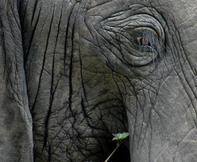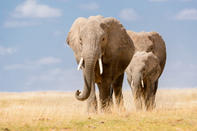Limited Eyesight
Elephants have an array of acute sensory perceptions to compensate for, or possibly resulting in, relatively limited eyesight. Their eyes are the same size as a human’s, which appear dwarfed on their enormous heads and they only permit clear focusing up to about 50 m.

The large ears actuate excellent hearing and their sense of smell is sharp. They use their trunks to collect scents at various levels often lifting them into the wind when investigating a particular intrusion. These scents stimulate the olfactory tissue but chemical clues collected simultaneously can also be placed into the chemoreceptors of the Organ-of-Jacobsen on the palate of the mouth for deciphering.
Loxodonta Africana

Size Bull: 3 m (at shoulder) Cow: 2,5 m
Weight Bulls: up to 6 tons (Heaviest bull on record 6569 kg) Cows: up to 4 tons
Lifespan 55 - 60 years
Habitat Every habitat in Africa with adequate food, shade and water including swamp, rainforest, woodland, savanna, desert, grasslands, hills, mountains and semi-desert.
Gestation 22 months
No. of young 1
Food Herbivores – catholic diet that uses 90% of local plant species including grass, herbs, sedges, aquatic plants, bulbs, tubers, roots, fruits, flowers, bark, wood, pods, seeds, leaves and entire branches.
Predators Lions and hyena prey on young, lions in some areas kill adults. Death also by parasites, disease and starvation.
Did you know? The skin of an elephant may be up to 4 cm thick in places, i.e. legs, forehead, trunk and back. It is thinnest behind the ears. The weight of an elephant’s enormous head is reduced by honeycomb-like formations in the skull.
By Megan Emmett